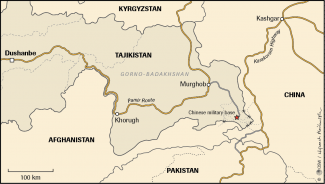China’s military presence in Tajikistan
The news published in the American and Indian press over the past few days confirmed the presence of a Chinese military base in south-eastern Tajikistan. Unofficial reports concerning this issue have been seen in the media over the past three years. The Chinese Ministry of Foreign Affairs claims that it does not know anything about this, while the government in Dushanbe insists that the reports concerning the base are untrue.
The base is located in a strategically important place, 12 km from the border with Afghanistan and 30 km from the Chinese border, where the traditional routes running from eastern Afghanistan to western China intersect. It is located in Gorno-Badakhshan’s Murghob District (it has an area of around 38,500 km², and a population of 14,000) bordering on Afghanistan, China and Kyrgyzstan in the Pamir Mountains. Satellite photographs suggest that the base, whose infrastructure includes heliports, is suitable for a lightly armed subdivision – maximally a battalion’s strength – supported by armoured vehicles.
Commentary
- Beijing is concerned about a possible influx of Islamic radicals and drugs to western China. The character and type of the units stationed at the base is unclear. However, there is no doubt that one of their tasks is to prevent the illegal movement of people between Afghanistan and Xinjiang, China’s autonomous region inhabited by Muslim ethnic minorities. Since the collapse of the USSR, the People’s Republic of China has adopted a strategy of slowly and regularly building influence in the Central Asian region – from an economic presence through a political influence to security co-operation since 1996 as part of the Shanghai Five (which has been known as the Shanghai Cooperation Organisation since 2001). In 2016, China struck a military deal – the Quadrilateral Cooperation and Coordination Mechanism – with Pakistan, Afghanistan and Tajikistan aimed at cooperation in combating terrorism and improving security. As part of the deal, China is building more than ten guardhouses for Tajikistan on its border with Afghanistan in the Pamir Mountains and has undertaken to equip and train a mountain brigade of the Afghan army.
- The location of the Chinese military base in the frontier zone may suggest that its existence is an unofficial form of repayment of Tajikistan’s debt and, possibly, the beginning of new territorial concessions to the advantage of the stronger neighbour. The weight of the Tajik denial of the Chinese military presence is tempered by the fact that the border adjustments to the benefit of China were denied in a similar manner in 2002 (and were formalised in 2011), owing to which Beijing gained valuable water sources (amongst other things). Similar territorial concessions were made by Kazakhstan (1996) and Kyrgyzstan (1998, revealed in 2001).
- The publication of the information by the US (Washington Post, 18 February) and Indian media, along with the publicity given to repressions used against Muslims in the People’s Republic of China, is an element of questioning Beijing’s influence. This also places Moscow in an embarrassing situation. Since the collapse of the USSR, Russia has viewed Central Asia as its zone of influence but it is forced to accept the increasing presence of China in this region. Thus Tajikistan is the first former Soviet republic (and also a member of a military alliance under Russian patronage: the Collective Security Treaty Organization) where the regular presence of Chinese soldiers has been confirmed. At the same time, Moscow has been unsuccessfully demanding from Dushanbe that Russian troops should return to the Afghan-Tajik border. Even though the Chinese military base in Gorno-Badakhshan is small, the issue sets a precedence and is further proof of Russia’s weakening position in dealing with China.
Map. China’s military base on the Chinese-Afghan-Tajik frontier





